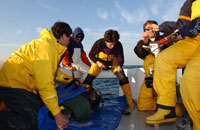As you can see from this map, this fish which we measured to be 272 cm in length (translating to 339 kg or 747 lbs in weight) moved a little way north up the Cape Breton coast in the three days between when we tagged it and when the tag popped up. We’re eager to see where it will move to by the time the longer-term tag we also attached to it pops up!
In addition to giving us a highly accurate measurement of the location where the tag popped off, the PAT tag transmits to satellites data on the depths and temperatures that the fish occupied, which tell us a great deal about the behavior of the fish. In the graph below you can see the temperatures and depths the fish experienced over the course of the three day deployment. The y-axis (i.e., the vertical axis) on the graph shows depth, while the x-axis (horizontal) indicates date. Water temperature is then shown via the color scale, with red temperatures indicating warmer waters and blue indicating colder. What you can see is that there is a region in the water column from the surface to about 30 m in depth where water temperatures are relatively constant at around 13C because the water in this layer is well-mixed. Below this mixed layer is a region referred to as the thermocline where temperatures drop rapidly. You can also see that the depth of the thermocline became slightly shallower over the course of the three days as the fish swam northwards.
This next graph shows the proportion of time during which the fish was in waters of particular temperatures. You can see that it spent most of its time in the 12-14 degree waters of this mixed layer and only spent a small proportion of each day in the colder and deeper waters of the thermocline. We think what it's doing is hanging out in the warmer waters of the mixed layer that it finds more comfortable, making only brief forays into the colder waters below to feed on the prey that must be found there. As we get more data back from the longer-term tag attached to this fish, and from the other fish tagged in these Nova Scotian waters, well learn much more about how the fish behave in this cold water region.




















































